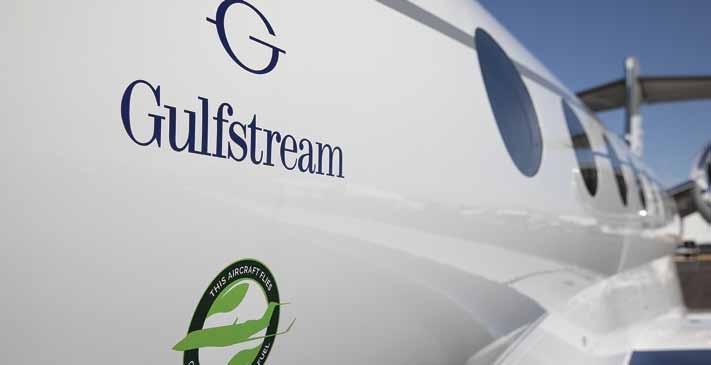
54 minute read
MESSAGE from PRESIDENT, BAOA
A SUPPLEMENT TO SP’S AVIATION BizAvIndia
VOLUME 6 • ISSUE 4
Advertisement
WWW.SPS-AVIATION.COM/BIZAVINDIASUPPLEMENT
P 5 THE OPPORTUNITY TO RETHINK AND REINVENT BUSINESS AVIATION IN INDIA
P 12 EXCLUSIVE INTERVIEW: PRESIDENT, GULFSTREAM CUSTOMER SUPPORT
P 16 BUSINESS AIRCRAFT CABINS ENHANCE SAFETY FOR A POST COVID-19 WORLD
P 19 FLYING PRIVATE SOARING HIGH!
+ MORE...
PAGE 8 THE ‘FIRST TRULY PRIVATE HELICOPTER’
BizAvIndia Cover 4-2020.indd 1 25/11/20 12:50 PM On the cOver: The HX50 has been conceived as a genuinely best of breed personal helicopter, crafted upon fieldproven engineering, state-ofthe-art manufacturing and iconic British design. Every minute detail has been elaborately crafted to deliver a helicopter specifically focused on the needs of private owners. cover Photograph Hill Helicopters
PAGE 5
industry operations
By sudhir s. rajeshirke, Vice president – sales, arrow aircraft sales and charters pVt. ltd.
PAGE 8
innoVation hill hX50
The ‘First Truly Private Helicopter’
By ayushee chaudhary
PAGE 12
EXCLUSIVE interView
PAGE 16 coVid-19
innoVation
By ayushee chaudhary
PAGE 19
coVid-19 silVer lining
Flying Private Soaring High!
By rajan mehra, chief eXecutiVe officer, cluB one air
PAGE 21
social imPact sustainaBility
By ayushee chaudhary
Volume 6 issue 4
Contents
the hX50 is designed, developed and manufactured in Britain to deliver an eXquisite flying and ownership eXperience
regular departments
2 from the editor’s desk
3 23 MESSAGE from PRESIDENT, BAOA NEWS AT A GLANCE
Awards 2017 Special Contribution to business AviAtion
Publisher And editor-in-Chief
Jayant Baranwal
PrinCiPAl CorresPondent
Ayushee Chaudhary
Advisory boArd
Air Vice Marshal S.S. Chauhan (Retd) President, BAOA Group Captain R.K. Bali (Retd), Managing Director, BAOA
ChAirmAn & mAnAging direCtor
Jayant Baranwal
PlAnning & business develoPment
Executive Vice President: Rohit Goel
design
Designers: Vimlesh Kumar Yadav, Sonu S. Bisht
grouP direCtor – sAles & mArketing
Neetu Dhulia
dePuty direCtor – sAles
Rajeev Chugh
mAnAger – hr & Admin
Bharti Sharma
AssistAnt mAnAger – hr & Admin
Pooja Tehlani
dePuty mAnAger – CirCulAtion
Rimpy Nischal
grouP reseArCh AssoCiAte
Survi Massey
sP’s websites
Sr Web Developer: Shailendra P. Ashish Web Developer: Ugrashen Vishwakarma © SP Guide Publications, 2020
Advertising
neetu@spguidepublications.com rajeev.chugh@spguidepublications.com
sP guide PubliCAtions Pvt ltd
A-133 Arjun Nagar, (Opposite Defence Colony) New Delhi 110003, India. Tel: +91 (11) 24644693, 24644763, 24620130 Fax: +91 (11) 24647093 E-mail: info@spguidepublications.com
Owned, published and printed by Jayant Baranwal, printed at Kala Jyothi Process Pvt Ltd and published at A-133, Arjun Nagar (Opposite Defence Colony), New Delhi 110 003, India. All rights reserved. No part of this publication may be reproduced, stored in a retrieval system, or transmitted in any form or by any means, photocopying, recording, electronic, or otherwise without prior written permission of the Publishers.
MEMBER / PARTNER OF Adaptability, creativity, sustainability and the ability to re-structure garner focus amid pandemic challenges

Dear Reader, There is no one who has not felt the effects of the pandemic due to the novel coronavirus. With the expectation of another wave of the virus this winter season in many parts of the world, we are actually only witnessing on going effects, the after effects of which will probably be seen later. However, while this crisis got everyone on their toes and took industries, especially the aviation industry by a jerk, it is also an opportunity to cash on. The halt brought about by this crisis has presented everyone to pause for a moment, prepare them better and innovate, to come up with adaptive ways that will help them to move on and sustain.
Through his message in this edition of BizAvIndia, BAOA President AVM S.S. Chauhan (Retd) highlights that the pandemic might have been a curse, but it also presents a unique challenge to make necessary changes and design safer future for travel. A report by Sudhir S. Rajeshirke from Arrow Aircraft also highlights the need to rethink and reinvent business aviation in India. He believes that the industry can not only create a huge impact on jobs and economy but also bring about a change in perception on usage of corporate or charter aircraft that will further enhance corporate productivity. Also, in another article, Rajan Mehra, CEO of Club One Air points out how safety is becoming a highly sought-after commodity and is in turn nudging the wealthy towards private aviation.
Innovation is thus at the heart of the industry with everyone taking necessary steps to ensure passenger confidence. The business aviation industry is also resuming with precautions and coming up with enhanced assurances to get traveller’s back to flying. A major aspect of these practices is the cabin experience. Industry experts had anticipated that the virus will initiate structural changes in the market, which will pave way for new cabin layouts and some of these innovations have been highlighted in this edition.
A report by Ayushee Chaudhary takes us through ‘the first truly private helicopter’ which is set to redefine the helicopter industry. The five-seater HX50 unveiled by Hill Helicopters is being presented as the high-tech and high-performance personal aircraft that is a fusion of performance, technological innovation and artistic elegance.
In an exclusive interview, Derek Zimmerman, President, Gulfstream Customer Support talks to BizAvIndia with special emphasis on customer services and the various initiatives by the manufacturer in that direction.
In a report on the sidelines of BizAv Sustainability Summit, Ayushee Chaudhary highlights the increase shift to alternative fuels and the steps taken by Gulfstream and other manufacturers for the same.
All this and much more in this issue of BizAvIndia. Welcome aboard and we wish you many happy landings!
J. Baranwal Editor-in-Chief
president
Business AircrAft OperAtOrs AssOciAtiOn
An Opportunity to Make Air Travel Safer!
“Cash is King”, but “The One Who Will Provide Cash (in these Corona-hit times) Is The Emperor!”
The field of aviation is as distinctly different in its infrastructure & operational details, as are many other fields that form the backbone of a nation’s economic activity today. In turn, the main sub-parts of aviation consist of: l The Aircraft Production & Distribution (Sales & associated) Centres, l The Aircraft Exploitation (the scheduled-, the non-scheduled- & the private owner-user) Centres & the Support (MRO/associated support) Centres, l The National Governments, the National Regulatory Authorities, the International Monitoring Agencies & other associated Regulatory/Support elements.
These sub-parts/sectors interactively affect each others’ performance & results. As such, in the ‘Commercial Aviation Sector’, the existence & performance of the smaller ‘Business Aviation’ in India cannot be viewed in isolation from the existence & performance of its nearest ‘Big Brother’ i.e. the ‘Scheduled Airlines’.
In the current century, so far there have been three major downturns in aviation - the first in the year 2001 after the “9/11 event”, the second in the year 2008 caused by the “Economic Recession”, & the third this year (since around March 2020), triggered worldwide by the “COVID-19 Pandemic”.
After the first two downturns, with the consistent human endeavour & efforts that followed, aviation bounced back with increased momentum over a period of time. As such, it is expected that the future of aviation, after the current downturn, would be no different & that it will certainly bounce back within (as yet unpredictable but hopefully) a short span of time. With this optimistic note, we need to assess the current indicators, challenges & opportunities in different sectors of the aviation infrastructure.
A random sampling ‘in bullet form’ is presented below, for a “Quick Gun Murugan” style of reading: l According to Moody’s, Commercial Aviation will be ravaged by the COVID-19 pandemic for years to come. Every stake holder, from plane manufacturers to plane lessors, airlines to airports, MROs to parts suppliers, (et al), will be squeezed, with effects rippling across the entire global economy. l Major rivals Airbus & Boeing have each announced plans to cut over 10,000 jobs, with more to follow. l Airbus has reportedly suffered more than $3 billion net loss in the first 3 Quarters of 2020. l Boeing suffered over $3.5 billion losses for the same period, mainly due to both world-wide grounding of its 737 MAx fleet in 2019 & the onset of the ‘Covid event’ since early 2020. l Large aircraft such as the Boeing 747 & the Airbus A380 are not needed anymore, as they are difficult to fill. Once again, “Small is
Beautiful & the Smaller the Better!” l The last downturn resulted in a number of private aircraft being put up for sale at low distress prices. In the present COVID-19 induced downturn, there has been an actual decline, however small, in the number of used business aircraft put up for sale, compared to the corresponding period last year, prices somewhat holding with a downward trend limited to only about 10 to 15 per cent.
l
l
l
l l
l
l
l l
l
l
l
l
l
l
l As of August 2020, the General Aviation (GA) fleet in China stood at over 2,900 aircraft, includes over 150 GA aircraft added in the current year (Total Civil aircraft count was 6,134 in 2018). In comparison, in India the total number of BA/GA aircraft are on the decline, the present number (both fixed wing & helicopters) stands at a mere 500 only (Total Civil aircraft count around 1,190) - a whopping difference of more than 500 per cent in total Civil or just the BA/GA aircraft! In Q3 of 2020, American Airlines Group announced a $2.4 billion loss & Lufthansa reported an operating loss of €1.26 billion ($1.46 billion). In Q2 of 2020, the aviation industry of China, the originator of COVID-19 event, suffered a loss of just over 34 billion Yuan ($5 billion) & the Singapore Airlines Group suffered over SGD 1.1 billion ($800 million) loss. IndiGo, the largest Indian airlines, declared a net loss of `2,844 crores in Q1, 2020. Many other well-established International & National airlines, from Alaska to Australia/New Zealand via Europe, Middle East & the Asian subcontinent, have also reported depressingly huge losses in their quarterly 2020 financial results so far! As per DGCA, the total domestic passengers that travelled by air in September this year has been 39.43 Lacs, which is 66 per cent lower than the corresponding period last year. The present ATF demand stands at only 48.5 per cent of normal. Reportedly many of the HNIs (High Net-worth Individuals), who would otherwise fly with scheduled airlines, are apparently moving towards Charter service. Many of these are entrepreneurs running small or medium scale enterprises or Chief Executives. Even here, small capacity business Jets or turboprops are the preferred choice as a more cost-effective solution. Current situation leaves little room for accurate predictions. IATA affirms view that air traffic will recover only in 2024. Global aviation trade associations/bodies have made a joint call ‘to the powers that be’ for a globally consistent approach for a faster recovery. Till date, more than 100 aviation-business related establishments/enterprises in distress world-wide have received more than $100 billion state aid in the form of grants, soft loans, operational subsidies, tax waivers or concessions, (etc). USA enacted the CARES (Coronavirus Aid, Relief & Economic Security) Act. This includes tax provisions that affect Business Aircraft Operators, in that the FET (Federal Excise Tax) does not need to be collected on amounts paid for Charter flights. The US Congress provided a $32 billion in payroll assistance to the US aviation industry in March 2020, while Senate Republicans agreed to the Airport Association’s plea for an additional $10 billion. Do the Government of India/Ministry of Civil Aviation have any specific “Indian-Aviation-Business-in-Acute-Distress” rescue/ recovery plan? And Finally: COVID-19 Pandemic may be a curse, but it also presents a unique challenge to make necessary changes to the technological marvel called ‘aircraft’ so as to make its design safer for future travel requirements. The infectious disease specialists consider the growing mobility of people via air transport as amplifying the potential for rapid transmission & dissemination of diseases. This is what happened in case of COVID-19 which originated in China but quickly spread to the rest of the world, silently infecting millions & killing thousands! What changes are required in ‘Aircraft Systems Design’ to overcome this flaw & improve the air traveller’s perception? Some progress has been made in making air travel safer with technology-based solutions & more is underway. Illustratively, these measures include: – Improved, virus-safe air conditioning/air circulation systems at airports & inside aircraft under development. – Rapid testing facilities, both pre-departure & post-arrival, being implemented at airports to restore air traveller confidence. – Use of ultraviolet rays for disinfecting multi-touch surfaces & use of Robots to perform certain repetitive functions that were normally carried out earlier by human beings. – Introduction of technology-based ‘Touch-less Systems’ at airports & inside aircraft cabins. – Mandatory health screening of passengers & staff as a standard practice at airports.
Statutory Caution: On the Side-lines, innovative ‘Mind Games’ are also under development. Consider this - “Most destinations require a negative coronavirus test result in order to enter a country or a city in the country. Instead of getting tested, some passengers are forging their certificates! As such, an “anti-forging vaccine” also needs to be developed in parallel by the law enforcement agencies!”
JAI HIND!
AVM S.S. Chauhan (Retd) PVSM AVSM VSM President, BAOA.
The Opportunity to Rethink and Reinvent
Business Aviation in India
By Sudhir S. rajeShirke
Vice PResiDenT – sAles, ARROw AiRcRAFT sAles AnD cHARTeRs PVT. lTD. The aviation sector in India continues to stay away from innovations partly due to high entry barriers and strong as well as non-adaptive regulations
During COViD-19, business aViatiOn shOweD a remarkable reCOVery Due tO neeD Of businesses tO traVel safely in the safety Of a priVate airCraft

We all remember the Monday early morning only seems to cater to the airline industry. and Friday late evening crowded commercial flights. Here are four reasons which justify why promoting business The propensity to execute businesses, build a vibrant aviation and providing the right stimulus to this industry will create economy and a better quality of life and to see new a healthier aviation ecosystem and spur the next level of aviation secplaces drove 4.5 billion air travel trips globally in 2019. tor growth in India. I have also added the enabling factors that can COVID completely changed the way people perceive travel. The drive business aviation growth. fear of travelling in crowded flights and getting infected diminished global air travel by more than 90 per cent. However, an unexpected 1. Business aviation can create a huge impact on joBs and trend emerged. Post lockdowns, while airlines have seen single digit economy growth compared to 2019 levels, business aviation showed a remark- Just as airlines do, business aviation companies employ highly able recovery backed by the need of businesses and HNWIs to travel skilled engineers, mechanics, flight despatchers, managers and safely for undertaking their businesses in the safety of private air- pilots and are supported by several organisations which provide sercraft and operators opening up new business models of selling seats vices such as aircraft maintenance, air charter brokerage, ground on private jets. Per WingX, The recovery in business jet traffic in handling, food and beverage and technology. Increase in the number USA at this point in Autumn 2020 appears to be hitting a ceiling of of business aircraft thus creates high quality career opportunities around 85 per cent of comparable 2019 activity. for individuals who wish to contribute to the aviation sector and also
India needs to take advantage of this situation and now focus on adds to country’s GDP. building a robust business aviation ecosystem and create another It also increases the possibilities for new businesses such as fixed parallel vibrant industry in the aviation sector. It is well documented based operators (FBO) which number less than five in India. Conand proven that it makes great economic sense for a number of sider this, per NBAA (in 2015), there were an estimated 3,000 FBOs companies and State Governments to use in US, generating $15 billion in annual revbusiness aircraft. Business aviation also enue. This was close to eight per cent of includes usage of helicopters for oil and gas total US airline revenue in the same year industries and also allows State Govern- and almost of the size of India’s airline ments officials to reach remote locations market. While it would be not be a fair to where otherwise would take an enormous compare a matured and sizeable US airamount of time. A well operated business IndIa needs to take line industry ($200 billion plus revenue in aircraft saves time, provides travel convenience, increases productivity, enhances security of high profile individuals and advantage of the exIstIng sItuatIon 2017) to India’s ($12 billion revenue in FY 2016-17), even a small possibility of establishing an FBO industry which is one per helps maintain privacy. But the purpose of this article is not to extol the benefits of business aviation. The and focus on buIldIng a robust busIness cent of India’s airline industry would mean a business revenue potential of approx. $100 million or `700 plus crore. This is purpose is three fold. First, it is to provide avIatIon ecosystem a sizeable market. Pilot and engineering a high level perspective on this industry which has generated millions of jobs and and create a parallel training for business aircraft is another area which can contribute to high quality added billions of dollars to the economy of vIbrant Industry jobs and revenue for training companies. several western countries, and which has Hence developing business aviation the potential to create similar impact on the further will grow the aviation sector sigIndian economy and thus create a holistic nificantly. civil aviation eco-system along with the airlines. This is required, given our Government’s focus on promoting airlines and giving a second 2. the right regulatory and operational frameworks grade treatment to business aviation. The second purpose is to provide for private aviation will help prepare the launch of four key reasons on impact that business aviation has on our economy new aerial transportation models and the third is to provide actionable recommendations which are Business aviation is mostly required on ‘on-demand’ basis and hence within the purview of the Government. it is unscheduled in nature. Unscheduled operations need strong
Business aviation has always been projected as having an aura operational support such as infrastructure (airport parking slots, of luxury and exclusivity. Promotions by air charter companies may rooftop helipads etc.), skilled professionals (engineers, pilots, operahave contributed to that image to a large extent. In a developing tions specialists) and regulatory support, which can provide quick country such as India, an image of a business executive or a high net approvals for on demand transportation. Such strong operational worth individual using a business aircraft to travel for business may and regulatory platforms will create the base for future aerial transseem ostentatious and smacks on the plight of the airline travelers portation systems, which could be ‘on-demand’ in nature. who have to brave long airport queues to get to their cramped air- For example, there has been a phenomenal progress in the develline seats. Hence a Government, which works hard to make air travel opment of drone technologies, flying cars and other modes of air accessible to large sections of the travelers by providing incentives to transportation for passengers and goods. There is a possibility that reduce cost of air travel (via UDAN initiatives) would obviously shy in the next five to six years we could see deployment of pilot proaway from promoting an industry which “appears” to cater to corpo- grammes for intra city aerial travel by air taxis/rickshaws or delivery rate excess. However, this prejudicial view against business aviation of goods to our doorsteps by drones (whether we like that scenario in India is detrimental to the overall aviation ecosystem, which now or not). Such transportation systems will require infrastructure (des-
ignated locations to take off and land), skilled professionals (drone partly due to high entry barriers and strong and non-adaptive regulapilots, air taxi pilots, engineers, operations specialists etc.), naviga- tions. Particularly the business aviation has been plagued with mindtional support and most importantly, balanced regulations. Their set fatigue i.e. it continues to follow the traditional marketing busioperations will compete with the same limited and regulated air- ness practices and operating processes in the same way as it has been space as with any other air transportation system. done for the past two decades. A few brokers tried to use technology
Hence unless we set up seamless operational and regulatory to drive aggregation but have not yet been successful as there was not capabilities for business aviation, setting up the same for future much of service innovation. modes of unscheduled aerial transportations would be difficult. For decades, business aviation companies in the US and Europe 3. a change in perception on usage of corporate or ownership, aggressive empty leg marketing, shared private flights, aircharter aircraft will enhance corporate productivity line partnerships by leveraging technology, investments and tax reguGovernment considers business aviation as an elitist segment. lations and thus bringing down the cost of chartered and private flights. Hence any attempt to ease the industry’s pain points is seen to pan- Charter brokers such as Victor and JetSmarter (now FlyXO) have levder to the corporate excess. This view has also percolated deeply in eraged technology and operating models to bring faster response times the minds of corporate shareholders. and new seamless experiences to private aviation customers.
We have seen instances where CEOs of public companies have Further, due to unscheduled nature of operations, entrepreneurs put-off their decision to purchase a business aircraft or use chartered can find several opportunities across the supply chain to bring value flights when it was direly needed. This was done from the perspective to business aviation and increase its reach to a wider section of air that the shareholders might think of an aircraft purchase or use of travelers in India. As a simple example, business aircraft owners chartered flights as an unjustified expense. and operators are required to establish a For example, in a recent instance share- complete organisation with several speholders of a well-known company ques- cialised staff if they have to operate even tioned the minor use of the chartered flights one aircraft. This not only increases cost of its CEO, who travelled for more than 500 of operations and but also adds to the hours in a year in commercial airlines. hassles of operating a heavily regulated
A business aircraft is an important tool for decades, busIness aviation company. This discourages a lot that gives busy executives the ability to remain “close to the customer” in a challenging business environment and reduces I avIatIon companIes n the us and europe of potential new owners from bringing airplanes in India. If such owners / operators are allowed to outsource their aircraft waste by saving thousands of hours of nonproductive travel time. The capabilities that these assets offer are as beneficial to have been enhancIng busIness models operations to a professional aircraft management company, which has the skills and capabilities of managing several airthe execution of business plans as the cellular phone, blackberry or laptop computer. Further, business aircraft have become by IntroducIng fractIonal jet craft and operates at scale, then it would decrease the cost of aircraft operations for owners and operators, avoid managmore efficient in design and performance. ownershIp ing regulatory hassles and improve ease of A team of three to four executives can efficiency of business aircraft. This would travel anywhere within India, especially encourage import of more aircraft and to tier 2 and 3 cities and return home the thus increase the overall aviation business. same day. The average cost per seat on a light jet is only slightly Thus if the regulations around aircraft management become more higher than a business class fare of a commercial airline. In addition, efficient, business aviation could become a great value proposition. executives can avoid overnight stay at hotels which not only saves costs, but they are also able to return home to their families rather what we need than spend a night at a hotel. Business aviation needs a few enabling factors from the Government
Hence the Government as well as company shareholders need to which will significantly help increase its potential in India. They are change their perspectives and understand that as executive time is as follows: the most valuable resource, a corporate aircraft should be treated as l Reserved space for business operations at airports: Whenever any a productive business tool and executive travel should be treated as airport traffic gets close to saturation the business aircraft operaan investment. If usage of private aircraft by senior political leaders tors get the first boot. Further, as new airports expansion plans are can be seen as a way to effectively reach out to their constituencies put in place there is little or no consideration given to allocate space and carry out efficient and productive travel, then the same perspec- for parking of business aircraft and an FBO. Hence when Airport tive needs to be accorded to business leaders as well. This can only Authority of India (AAI) plans new airports or considers expansion increase productivity of senior executives whose time and energy of existing ones, parking space should be allocated for business airare of utmost importance for business growth. craft for current and future aircraft inductions. A dedicated space 4. increase in entrepreneurial opportunities and potential business aviation traffic. Promoting business aviation India has developed a thriving entrepreneurial ecosystem which cov- should now figure in the civil aviation policy making process as well. ers many sectors such as retail, travel, logistics and supply chain etc. have been enhancing business models by introducing fractional jet should also be allotted to small or large FBO depending on historical However, aviation sector continues to stay away from innovations Continued on page 24...
The ‘First Truly Private Helicopter’
By Ayushee chAudhAry
With performance target of a 140-knot cruise speed, a maximum payload of 1,760 pounds, and a maximum range of 700 nm, the Hill HX50 is here to take the private flyers’ experience a notch up
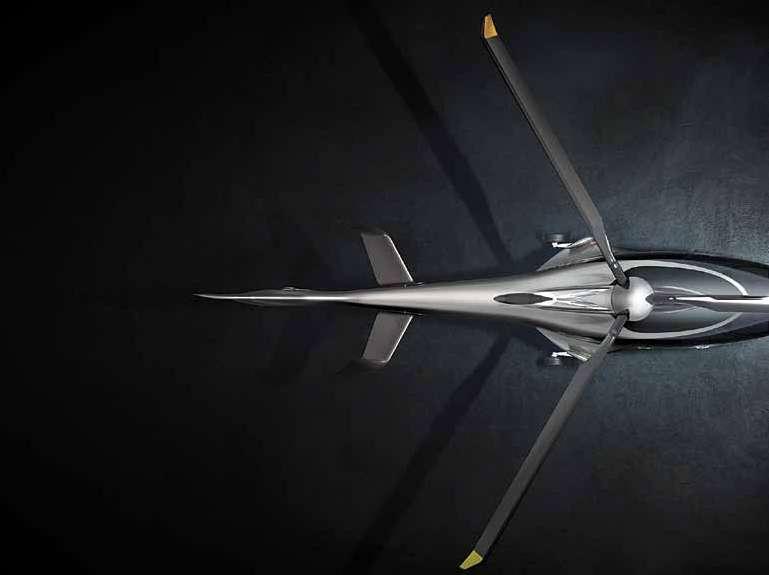
Redefining the helicopter industry, UK startup Hill Helicopters has unveiled HX50, the world’s first truly private helicopter, as the company puts it. The fiveseater HX50 has been conceived as a “best of breed personal helicopter”, crafted upon field-proven engineering, state-ofthe-art manufacturing and iconic British design led by the inspiring vision of helicopter pioneer Jason Hill, an aeronautics engineer and a pilot for about two decades. Researched and architected throughout the past 13 years, the turbine-powered, 500 horsepower clean-sheet rotorcraft is designed, developed and manufactured with a mission to deliver an exquisite flying and ownership experience.
The high-tech and high-performance personal aircraft’s composite structure and rotor system, optimised engine, re-imagined avionics, and elevated interior design make it a fusion of re-defined performance and artistic elegance.
Further, Hill Helicopters (HH) is sure that their helicopters are affordable and inexpensive to operate while delivering an unprece-
The hX50 is a Truly desirable, aTTainable and capable aircrafT ThaT will relaunch general aviaTion dented level of performance that provides the fastest, most direct way to travel opulently over intermediate distances. The HX50 elegantly embodies the finest in power, technology, safety and refinement ever offered to the general aviation market. It isn’t so much a helicopter, but rather the first aerial Grand Tourer ever built, states HH.

For the private Flyers
The HX50 will deliver a truly desirable, attainable and capable aircraft that will re-launch general aviation, believes Jason Hill.
The company is affirmative that the launch of HX50 is set to revolutionise private aviation industry. “Our product, its very definition and DNA is focused on the specific needs of private owners, their usage patterns and specific missions. Additionally, we make the best 5-seat helicopters in the world,” Hill Helicopters stated in an interaction with BizAvIndia.
Here’s what they say makes HX50 the world’s first truly private helicopter: l It’s the first light helicopter to be specifically designed for private owners. l It delivers enough performance and payload to take 4 passengers, all the bags and three hours of fuel to fly wherever, in fantastic comfort and in an amazing environment.
“We make using a helicopter for personal business travel, recreation, and touring EPIC! We make it financially and technically viable and extremely desirable, to fly yourself or be flown wherever you want to go, inexpensively, at a moment’s notice with the highest levels of safety and with a sense of occasion and theatre never before seen,” Mischa Gelb, Sales and Marketing, Hill Helicopters told BizAvIndia.
HH also suggests that if one does not have an incredible long distance to go then taking the Hill HX50 allows you to fly to a business meeting (for example in the city) directly from the backyard further saving time and enhancing efficiency.
Making Flying a luxurious, intuitive & convenient experience The design of the Hill HX50 has been carried out keeping in mind the convenience of the user. As the company puts it, from the striking iconic beauty of the exterior to the airy uplifting interior, everything
hx50 – speciFications
Cruise Speed – 140 kt Horse Power – 500 shp Payload – 1760 lbs 800 Kg Max Range – 700 nm 500 mm Wide Seats | 4 - Point Harness | Full Climate Control | Bluetooth Connectivity
payload 1760 lBs (800 Kg)
People – 5 x 200 lbs (95 kg) Bags/Cargo – 60 lbs (27 kg) Fuel – 700 lbs (317 kg) 3 hours fuel 420 nm Range
engine hill gt50 turbine r66 hX50
SHP 300 HP 500 HP T/O Power 270 HP 440 HP Continuous 224 HP 400 HP Fuel @110 kts 22 GPH 22 GPH Fuel @140 kts N/A 35 GPH
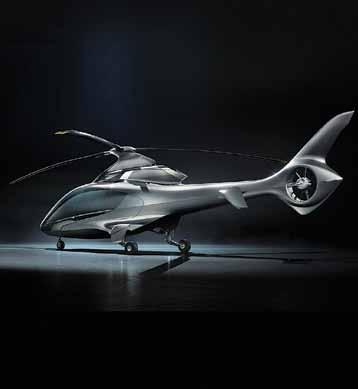
has been sculpted with uncompromising comfort in mind, to make the journey every bit as desirable as the destination. HX50’s forward flight speed and efficiency have been delivered through state-of-art aerodynamic design and testing.
HH also states that aircraft interiors have long lagged behind their automotive peers, however, the unique attributes of Hill HX50’s interior environment far exceeds automotive design. A masterful blend of art and science is at the heart of the pioneering redesign of the helicopter.
The HX50’s groundbreaking cabin delivers a complete rethink of helicopter flight for the pilot and those who prefer to be flown. Combining redesigned flight controls, full glass instrument panel, panoramic windows and skylights, exclusive leather seating, and a host of luxury features, the HX50 boasts of a stylish interior.
The HX50 delivers five wide seats, giving the pilot and each passenger unprecedented levels of comfort. The seats and cabin are crafted from the finest materials, combining two-tone Nappa leather, French stitching, alcantara trim and first-class brushed metal. Each seat offers personal storage, USB ports and four-point harnesses. Climate control and Bluetooth connectivity are also provided throughout the cabin.
The HX50’s cockpit was re-imagined to upgrade flying from a piloting, comfort, convenience, ease-of-use and sheer exhilaration perspective. Sitting front and centre in easy reach and sight of both pilots, it delivers convenient navigation, weather and traffic information, in addition to providing a backup display of the flight instruments. HH noted that in recent times, many pilots have started using iPad apps for flight planning and navigation. At the heart of the Hill Digital Cockpit is the use of these apps, with the iPad front and center, fully accepting that it can perform better than many existing hardware avionics, and embracing the fact that this is how people want to fly. The cabin and avionics suite embrace the empowering role that the iPad plays in simplifying and improving the modern recreational flying experience. The clean, uncluttered cockpit also delivers automotive levels of simplicity of operation, genuinely raising the VFR flying experience to new highs.
The electronic flight displays, have been completely redesigned for clear communication of essential information, while pilot interaction with aircraft systems, avionics and flight controls has been streamlined to the same extent that would be expected of modern premium automobiles.
The unique integrated pilot interface (IPI) provides a userfriendly controller and numerical keypad, along with intuitive selector keys for fast access to routinely required functions. The collective is conveniently integrated with a centre console and armrest to dramatically improve pilot comfort. The cyclic combines pilot adjustability, ease of entry and egress and outstanding ergonomics of both the hand grip and buttons.
The HX50 light-single is designed to take five 95 kg passengers and all of their bags (about 27 kg cargo), 317 kg fuel and 420 nm of range, plus three hours of fuel at max continuous power, flying without any performance limitations all the way up to 10,000 ft. What is further noteworthy is that this is just a standard configuration and the configurations can be further customised as per the requirements. The rear seats are elevated, and the glazed cabin roof and low window line deliver an unrivalled airy and open space, sublime comfort and peerless connection with the panoramic views to the outside.
Hill Helicopters also revealed that it is developing its own turbine engine for the platform, designated the GT50. The Hill GT50 combined is a hybrid of aeronautical and industrial gas turbine technology which benefits from manufacture processes and infrastructure developed for the automotive turbocharger market.
Market Research
2007 2008
Product Definition
hx50 – tiMeline
Technology Development
Aircraft Development
2010 2015
Aircraft Design 2020 Q4 2020
Pre-Orders Launch Production
2023
the hx50 and other light helicopters
When asked how different would their helicopter be compared to say Bell, Airbus, Leonardo, Sikorsky, etc. in terms of speed, altitude, seating and comfort, Gelb told BizAvIndia that most helicopters are built as a working machine and not specifically made for the private sector. The HX50 focuses on the highest speed in its class while the altitude performance is quite similar to others. Being a VFR aircraft, it won’t be capable of flying in or above the clouds. It has five seats and is built with an opulent spacious interior that is at the same standard as a high end automobile. “There is no helicopter in this space that is anything like what the HX50 is. It will stand out from all its competitors in the market,” adds HH.
One important highlight is that the HX50 is a machine fundamentally designed for private pilots, many of whom have limited experience or fly relatively infrequently and this helicopter fits that purpose with features such as: l High-inertia, three-bladed rotor system l Engine with large power reserves irrespective of load l Simple digital cockpit clearly presenting all flight information l Seamless integration with iPad and navigation apps
And because private pilots are unlikely to fly over 100 hours per year, the whole aircraft has a 5,000 hours life on condition. That means the value of the aircraft is protected and it won’t time out after a decade. It’s purely down to the amount of hours one flies and how well it is looked after.
“Traditional helicopters were designed to be utilitarian, with comfort as an afterthought. The HX50’s interior design is built around experience and comfort in the same manner as premium automobiles,” said Hill Helicopters CEO Jason Hill.
He further adds that the helicopter industry has long awaited an Elon Musk-style disruption that redefines the modern helicopter; the wait is over with HX50. “The HX50 brings aerospace design, performance, and safety as well as to the artistic and experiential aspects, including comfort, ergonomics, intuitive technology, and luxury together to deliver a truly unique aircraft and experience.”
Talking about the extreme weather conditions, they tell us that the HX50 is a very stable helicopter with a high inertia three bladed rotor system that enhances its stability in the wind. The rain does not affect the helicopter if the visibility is ok and there is synthetic vision in the helicopter to aid the pilot when the visibility is reduced. “Helicopters are inherently very capable of flying in bad weather as they have very highly loaded blades, compared to the wings of an airplane. The HX50 is a much more benign helicopter than a two bladed helicopter,” added Jason Hill.
HH also adds that when it comes to light helicopters, conventional wisdom would suggest that you cannot have a spacious, sumptuous interior with panoramic views for five passengers. It would also dictate that you cannot have a large bay to accommodate full-sized suitcases. And it would certainly remind you that vast fuel reserves for genuine touring would be out of the question. Except that these are exactly the attributes that make a helicopter flexible, desirable and worth owning. The HX50 has been developed according to the laws of physics, not conventional wisdom, and delivering these capabilities is precisely what gives the HX50 true purpose, genuine usability, and a peerless spot in the market.
Bookings and launch
Reportedly the HX50 is in the advanced design phase currently, with three prototypes scheduled to begin flight testing in 2022. Hill Helicopters have started to take pre-orders through private presentations explaining the details of the HX50. People can visit their website and book a private presentation to learn more about pre-ordering. The first deliveries are planned to commence by May 2023.
Discussing about the unprecedented times that the world and the aviation sector is gravely bearing, Jason Hill told BizAvIndia that this change has rather been a time of opportunity for Hill Helicopters. “We have all our development in place. The only thing that COVID-19 has done for us has meant that we have got some more money from the UK government to support our project so it has been nothing but good for us. Of course it has been a bit inconvenient with the lockdown as it’s a little difficult to work on this kind of project by just being virtually connected. However, the timeline will not be affected by COVID per say,” he added.
He further believes that the people who buy helicopters are more robust than many when it comes to the pandemic and once everyone is out of this pandemic, at the time of our production we expect buoyancy. Although right now Hill is targeting private flyers, there will be models in the future that would be targeted for the commercial sector. BAI
special price oFFer
Under the 100 Friends of Founder programme, the special price for Hill HX50 is £295,000. For any order received under these two conditions: l purchase order received until the end of the month (November 30th) and deposit paid until December 31st and l up to serial number 25 (included). You will be receiving at no extra cost: l The Blade folding kit plus l The Helimove (motor system on the wheels to roll the helicopter into the hangar).

In an exclusive conversation with Jayant Baranwal, Editor-in-Chief, BizAvIndia, Derek Zimmerman, President, Gulfstream Customer Support talks about how, for more than 60 years, Customer Support has been central to Gulfstream’s vision of delivering the world’s finest aviation experience for which Gulfstream has steadily grown their company-owned support network by investing heavily in facilities, equipment, systems and training.

Gulfstream field and airborne support teams
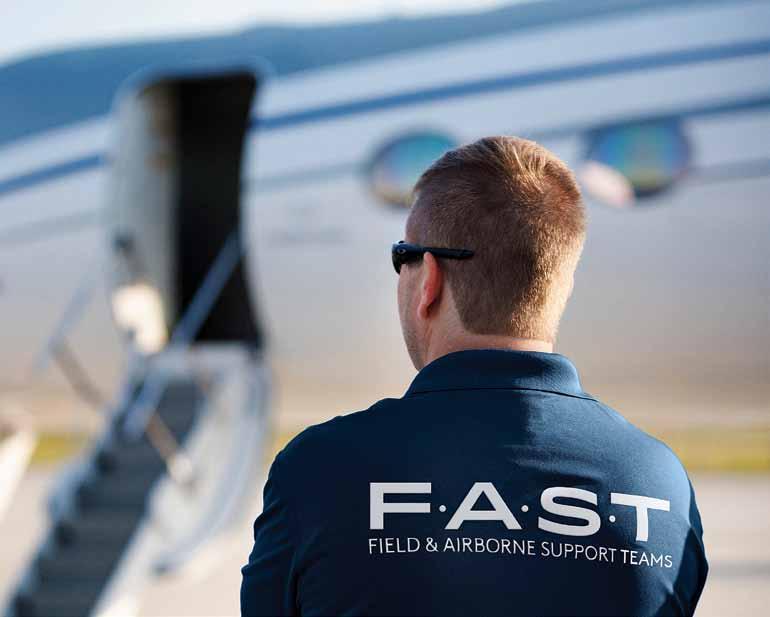
BizAvIndia (BAI): Can you indicate on the key locations of your customer support network around the world?
Derek Zimmerman (Zimmerman): Around the world, Gulfstream has 11 company-owned service centers; six factory-authorised service centers run by our sister company Jet Aviation; 18 authorised warranty facilities; and one company-owned component repair center.
Our US-based company-owned service centers are strategically located in Savannah, Georgia, where our headquarters is based; Brunswick, Georgia; Westfield, Massachusetts; Palm Beach, Florida; Dallas, Texas; St. Louis, Missouri; Appleton, Wisconsin; Van Nuys and Long Beach, California. International company-owned service center locations include Beijing and Farnborough, England, just outside of London. “Around the world, GulfstreAm hAs 11 compAny-owned service centers; six fActory-Authorised service centers run by our sister compAny Jet AviAtion; 18 Authorised wArrAnty fAcilities; And one compAny-owned component repAir center”


(left) Gulfstream Customer support distribution Center; (riGht top) Gulfstream fast Center; (riGht above) Gulfstream fast airCraft

BAI: In case of any urgent parts’ replacement/fixing requirement comes up, what’s the turnaround time?
Zimmerman: Gulfstream Customer Support has systems in place to quickly identify and address a situation in need of maintenance, sometimes even before the customer is aware. We do this in large part through the Gulfstream FAST – Field and Airborne Support Teams – Center, a dedicated support center focused solely on ensuring fast return to service of customers’ grounded aircraft.
The FAST Center is located in the Gulfstream Savannah Service Center, the world’s largest and most technically advanced maintenance facility built specifically for business jets, and is staffed by an enterprise-wide team of experts dedicated to predicting, preventing and resolving maintenance or logistics issues that would prevent an aircraft from making its next flight.
Requests, if designated an “AOG,” or aircraft-on-ground condition, are routed to the FAST Center, where experienced team members have Gulfstream’s vast worldwide resources at their fingertips. These include multiple FAST aircraft to deliver parts, tools and technicians; field service representatives and FAST-dedicated technicians; mobile repair teams with specially equipped vehicles; more than $1.3 billion in spares inventory based around the world; and Gulfstream’s network of company-owned and authorised service centers and warranty facilities.
Technicians in the FAST Center can also keep a keen eye on customers’ aircraft in flight with Gulfstream’s PlaneConnect Health and Trend Monitoring (HTM). HTM works in the background to collect data on the aircraft system’s performance during a flight. Technicians can run real-time data inquiries in flight, and by the time the aircraft lands, notify the crew of maintenance needs. This sophisticated monitoring system allows for early detection and reduced downtime, resulting in an efficient and quick return to service for the aircraft.
BAI: Please tell us more about your Aircraft Ownership Service? How exactly does it work and how is it different from other such services?
Zimmerman: Gulfstream is the only large-cabin business-jet OEM to offer a full concierge service for owners, with the Aircraft Ownership Service (AOS). This turnkey service allows customers to tailor the suite of services they would like Gulfstream to handle on their behalf, whether that is scheduled and unscheduled maintenance, parts and labour; technical information (publications and subscriptions); major vendor support programmes integration (engines, auxiliary power units, avionics); on-site operational staffing and support; hangar accommodations; connectivity packages and more. In cases where Gulfstream vendors supply the part or service, the customers’ Gulfstream AOS representative takes care of all the logistics.
BAI: Does Gulfstream ensure that the turnaround time of services and support to the customers remain the same, no matter where there are, in the world?
Zimmerman: Gulfstream Customer Support has strategically placed parts and people around the world to maintain as consistent as possible an experience for the customer, regardless of where they may be.
To ensure availability of parts, which is a key component of a quick return to service, Gulfstream has created a vast distribution network. In addition to Gulfstream’s state-of-the-art, 4,05,868-squarefoot/37,706-square-meter Customer Support Distribution Center in Savannah, the company has established distribution centers around the world, including Van Nuys, California; Teterboro, New Jersey; Amsterdam; Basel, Switzerland; Hong Kong; and Singapore. Seeing the opportunity to further expedite parts deliveries, Gulfstream recently opened a new distribution hub in Atlanta, within two miles of the city’s busy Hartsfield-Jackson Atlanta International Airport.
Of course, those parts need technicians, too, and we have positioned hundreds of field service representatives and FAST technicians around the world to support customers where they and their aircraft are. The technicians and support personnel in our companyowned service centers also share a common organisational structure, standardised quality systems and workflows, and well-connected functional leadership to help maximise effective throughput and a consistent, world-class experience.
BAI: How do your services differ from the competitions? What are the key pillars of your level of customer support?
Zimmerman: For more than 60 years, Customer Support has been central to Gulfstream’s vision of delivering the world’s finest aviation experience. We have steadily grown our company-owned support network over several decades by investing heavily in facilities, equipment, systems and training. We focus exclusively on Gulfstream aircraft and continue to perform maintenance work on most of the Gulfstream fleet.
Over the years, we’ve always listened to and learned from our customers in order to use their feedback and knowledge to help shape our strategy. As a result, our workforce has developed an incredible depth of knowledge and competency and has earned the trust and loyalty of our owners and operators. Customers expect and value the expertise of our teams and the unmatched support they provide anywhere in the world.
Along with AOS and other Gulfstream Customer Support programmes, our ultimate goal is to make the aircraft ownership process as seamless as possible, so our customers can focus on their success and the success of their business.
Gulfstream fast truCk and airCraft

BAI: What is the thought behind Gulfstream having more factory-owned service centres?
Zimmerman: We simply believe the relationship with our customers is too important for us to be anything other than fully committed. One of the top reasons a customer purchases a Gulfstream is because they have full confidence we still stand behind them for years after the initial delivery. The best way for us to do this is to be there when they need service or support, and that also gives us the opportunity to learn from every shared experience. This creates a razor-sharp focus coupled with unmatched capability, capacity and competency.
BAI: Do you face any set of challenges in keeping Gulfstream Field and Airborne Support Teams (FAST) ready at all times around the world?
Zimmerman: Thanks to the strategic placement of Gulfstream FAST technicians and field service representatives around the world, along with our parts distribution network, Gulfstream Customer Support has a nimble and geographically diverse support team to maintain readiness. We’ve been able to continuously evolve and grow over the years along with customer needs and changing conditions. BAI

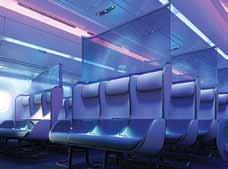
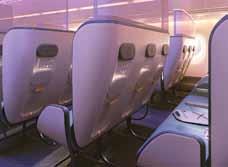
(top) Duncan aviation has implementeD an aircraft Disinfection service; (above left) the pure skies Zone features a combination of staggereD anD non-staggereD seat configurations helping to maximise the feeling of personal space; (above miDDle) each pure skies Zone seat features a folD Down table with wireless charging anD integrateD uvc cleaning, a backlit safety carD anD a Device holDer; (above right) DiviDing screens every other row in the pure skies Zone help alleviate passenger anxiety.
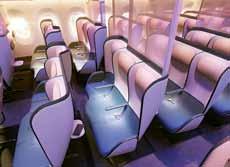
By Ayushee ChAudhAry
To regain passenger confidence and ensure a safer commute, business aviation industry is also taking advanced innovative steps to rework the cabin interiors of the aircraft
As the coronavirus pandemic took over, travel was already superior to those of commercial airliners especially due to one of the most affected sectors because of the immediate smaller cabin volume. Business jets also do not have nearly as many halt that was exercised on the industry in an attempt to passengers to protect from each other and flights in those aircraft curb the spread of the virus. However, the way forward tend to be shorter, thus reducing the risk of infection. But that does is always adaptability and innovation which is what the not mean that business aircraft cabins do not require any considerindustry has been moving towards. ation at all.
Amid many other possible reasons for the spread of the virus, one Here are some examples from the industry who are taking certain major concern that had emerged, when it comes to air travel, was steps in the direction of achieving a healthy cabin space in the aircraft. the low relative humidity levels in aircraft cabins. Health experts NBAA stated Meghan Welch, interior design specialist for Elliott had highlighted that low humidity levels are a critical factor in the Aviation, agrees that while operators should certainly observe best spread of COVID-19 because dry indoor air is like an accelerant that practices when it comes to cleaning and disinfecting cabins and vetturns small viral outbreaks into massive viral bombs. Low relative ting the health of passengers, her company has not made major alterhumidity in aircraft cabins tends to create a host of problems includ- ations to the interior designs of the airplanes that it typically deals ing vulnerability to the disease. It was also pointed out by some that with (from turboprops to mid-size jets). However, Elliott Aviation is this could especially be problematic on long intercontinental flights making use of antimicrobial materials in some of its upholstery, side with fewer people on board because the breath of passengers sup- panels and other often-touched surfaces. This technology involves plies much of the humidity that does exist in aircraft cabins. This incorporating virus-fighting elements into fabrics and other intedrew the business aircraft as well into focus even though it is among rior materials. A coating with a chemical compound that is toxic to the safest mode to travel in a corona-like situation. A study by Euro- micro-organisms can be applied to surfaces to minimise the chance pean charter operator Globe Air although found that the air supply of a virus surviving very long. Such compounds also can be absorbed on a business jet is better overall, due to the smaller aircraft dimen- in a polymer material. sions and lower passenger numbers. Nordam Group, which specialises in fabricating composite compo-
As the perceived risk of spreading airborne viruses in the cabin nents used in aircraft interiors, is exploring the potential of Ultravioletcame to the forefront, the use of High Efficiency Particulate Air C lighting as a possible replacement for standard lighting over high(HEPA) filters came into the focus. This system uses 50/50 fresh air touch areas, such as tray tables, because of its disinfectant qualities. from outside the cabin and recirculated air, which passes through fil- While Duncan Aviation has put together a group from the interiters. HEPA filters capture over 99 per cent of airborne viruses and ors segment to look at products with more safety measures in mind. are as effective as those found in hospital operating theaters, accord- It has also changed its procedures to include a comprehensive cleaning to IATA. ing of every aircraft coming into its shop, using a fogging process and
As the months have passed since the arrival of the novel coro- wiping down the cabin and the flight deck. navirus and activities have started to As far as cabin systems are concerned, resume with precaution, the business Duncan Aviation has reportedly been aviation industry is also coming up with impressed with Aviation Clean Air’s bipolar enhanced assurances to accelerate confi- ionisation system. The unit floods the cabin dence in the passengers. A major aspect and flight deck with positive and negative of these practices is the cabin experience. Industry experts had also remarked earPriestmanGoode has ions that attach to oxygen and hydrogen atoms that then “surround” particles of lier that as the virus will initiate struc- introduced uVc liGht most known viruses and render them inert. tural changes in the market, it will pave way for new cabin layouts. In a recent report by National Busiand heat cleaninG, in combination with The system has been STCed on numerous large-cabin business airplanes, and Duncan is looking at possible applications on ness Aviation Association (NBAA) also highlighted how COVID-19 is changing business aircraft cabins. “Aircraft manuPhotochromic and thermochromic inks smaller aircraft. London-based design studio, PriestmanGoode, revealed a new design confacturers and interior completions specialists have responded to the COVID-19 crisis by rethinking cabin designs and materials in the materials and finishes. as the cept ‘Pure Skies’ that includes a complete review of Business and Economy Class cabins and addresses pressing consumer, and developing various ways to combat heat from cleaninG business and environmental concerns. pathogens,” the report stated. To protect and reassure passengers, airlines are undertaking high-profile meareacts with the inks, a messaGe of The concept has been developed around three main factors: l Personal space sures to help make cabins safer. “Air filtration systems have been beefed up, and airline interior specialists are exploring ways reassurance aPPears on seats, helPinG l l Hygiene Touch-free journey Nigel Goode, Co-founding Director at to cocoon individual passenger seats with protective barriers,” added NBAA’s report. However when it comes to the busialleViate PassenGer anxiety about hyGiene PriestmanGoode stated in a press release, “This latest work from the studio represents pragmatic innovation. With the benefit of ness aircraft, NBAA said that business durinG boardinG. over 30 years’ experience, we know how to jets’ pressure and air filtration systems are harness design to achieve long-term posi-

(left) seat fabrics incluDe photochromic anD thermochromic inks that react to new cleaning methoDs like uvc anD heat cleaning; (right) gulfstream Doubles Down on cabin air purification
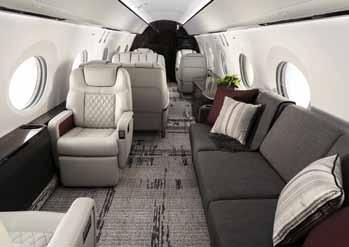
tive change. We’ve looked ahead to imagine future scenarios and taken in the new Cessna Citation Longitude, and the popular Latitude jet. into account new passenger behaviours driven by the global pandemic Even Embraer offers them on its new Praetor 500 and 600 jets. to ensure our designs can be implemented within a few years and will Gulfstream Aerospace is also making its cabin air additionally meet user and airline requirements for many years ahead.” cleaner with a new plasma ionisation system that operates when the
PriestmanGoode has introduced UVC light and heat cleaning, aircraft environmental control system is active. It emits positive and in combination with photo-chromic and thermo-chromic inks in negative oxygen ions that inactivate harmful molecules on surfaces the materials and finishes. As the heat from cleaning reacts with the and in the air, stated the manufacturer. Further, it neutralises particinks, a message of reassurance appears on seats, helping alleviate ulate matter including bacteria, viruses and unpleasant odors from passenger anxiety about hygiene during boarding. organic material such as cigarette smoke.
However it will take at least three years to develop and certify “The plasma ionisation system further enhances the cabin health future cabin products. PriestmanGoode has started to outline what benefits customers can expect from the signature Gulfstream Cabin these new products should be to ensure the future success of the air- Experience. By adding such a system in tandem with already 100 per line industry. The new built-in design, technology and material inno- cent fresh air and the proven Gulfstream airflow design, customers vation improve personal space and hygiene, and facilitate touch-free can fly their families and teams with even more peace of mind,” said journeys. The innovative cabin also includes features that empower Gulfstream President Mark Burns. passengers to tailor products around individual preferences. Besides airborne virus transmission, many infections – including
Many OEMs are also protecting passengers and crews from Covid-19 – can also be spread through particles that land on surfaces. viruses in several ways. Thus Jetcraft has teamed up with interiors
Bombardier’s Global business jets have specialist F/LIST to treat all eligible invena 100 per cent fresh-air system, in addi- tory aircraft with MicroShield 360, an innotion to an air purification and circulation vative antimicrobial treatment for cabins. system known as Pur Air. A HEPA filter Jetcraft highlighted that MicroShield captures up to 99.9 per cent of allergens, 360 forms a barrier of nano-scopic spikes bacteria and viruses and can completely replace cabin air in as little as 90 seconds, according to the company. Gulfstream aerosPace is also makinG its on the treated surface, which kills germs on contact, destroying the outer cell membrane like bursting a balloon. The system
Also, Bombardier service centers cabin air additionally is colourless, odourless, hypoallergenic offer Microshield 360, an EPA- and FDAapproved antimicrobial coating used for decades in the food industry to protect cleaner with a new Plasma ionisation and FDA-approved. As it’s a ‘mechanical’ treatment rather than chemical, it can’t be wiped away or removed by regular cleanagainst viruses, bacteria, fungi and algae. A global leader in international aircraft sales and ownership strategies, Jetsystem that oPerates when the aircraft ing, protecting the cabin for 12+ months after a two-hour application. “It goes without saying that we’re comcraft highlights that HEPA filters have been used in business aircraft for years, including the long-range Bombardier enVironmental control system is mitted to safeguarding our customers, so wherever they are in the buying process – taking a tour, enjoying a demo flight, or Global 6000, 6500 and 7500 models. In actiVe receiving the aircraft – they can be confithe midsize market, they are also found dent while on board,” stated Jetcraft. BAI
Flying Private Soaring High!
By Rajan MehRa,
Chief exeCutive OffiCer, Club One Air With safety becoming paramount in the pandemic stricken world and thus becoming a highly sought-after commodity for the wealthy, more and more of them are now turning towards private aviation
The aviation industry, along with hospitality and reopened and the wheels of industry are slowly taking off again, this travel have been hit the hardest due to COVID-19. During is the vein in which we must continue to evolve. Safety and hygiene April & May months, the global business loss is estimated have now become paramount. Being smaller in size, business jets to be to the tune of 20 billion Dollars. The Indian Avia- are easier to sanitize and cleaned. Social distancing has become an tion industry alone is estimated to crash-land this fiscal by important factor. `25,000 crore. We have adapted to this normal. Our aircraft are now completely
Even during the lockdown period, we kept our wheels moving sanitized. Our crew medical history is recorded and they wear PPE and evacuated people who were in need, transported sick passengers kits. Crew interface with clients is minimal. We provide masks and and operated special flights approved by the Government of India. sanitizers to every client. All our planes leave and arrive at the new We have had to innovate-find our way around obstacles, find cleverer General aviation terminal. This new terminal has made a huge differways of doing things, respect social distancing requirements, make ence for passengers who fly private, as there are no queues, minimum sure sanitation was on point. It is extraordinary what our ground han- interface with others and a very short distance to cover before you dling teams, air crew and support teams including drivers and help- reach in the aircraft! We have discovered that there is a new set of cliers could accomplish during the lockdown ents who have decided to shift from flying period and aftermath. commercial to the inherent, inbuilt safety
The good news for private charter of flying private. They would not like to put operators is that if Covid pandemic high- their families and themselves to the risk of lighted anything, it is just how much safer With safety becoming the pandemic at a crowded airport environand healthier it is it fly private! The luxury of private jet flying, which was typically associated with the rich and famous is paramount in the pandemic stricken ment and a plane full of a few hundred other passengers. I am confident that private aviation now focused on health and safety. With safety becoming paramount in the pandemic stricken world and safety becoming World and becoming a highly sought-after will grow exponentially, given the changing circumstances. Passengers now want to avoid the crowds at terminal buildings and a highly sought-after commodity for the ultra-wealthy, more and more of them are now turning towards private aviation. commodity for the ultra-Wealthy, more would prefer the spaces available in private aviation terminals. Inside the aircraft there will be a limited number of passengers all
As the world’s population begins to and more of them are known to them and with crew whose medislowly return to the skies, commercial aircraft are becoming increasingly crowded, and the alternative appears to be simple noW turning toWards private aviation cal history is known. Also they would be able to fly non-stop from anywhere to anywhere and to multiple locations on the same – fly private. Now many countries have day and time.
The luxury of privaTe jeT flying, which was Typically associaTed wiTh The rich and famous is now focused on healTh and safeTy
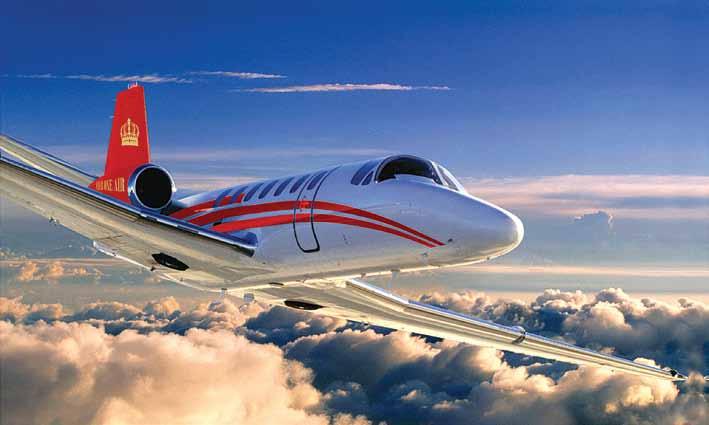
Another encouraging change we found was that more and aviation will be the winner post COVID-19. We expect to see a new more clients are now choosing to fly private for their international segment of passengers who may have been using first class or busitrips. These passengers previously restricted their private fly- ness class in commercial airlines but would now like the safety, ing to domestic journeys (for obvious budgetary reasons) but we convenience and hygiene of a private jet even though it may be have seen a very healthy rise in bookings during September and more expensive. the trend is continuing in October too. In September we recov- At Club One Air, we pride ourselves in providing global level ered back to the September 2019 flying figure and in October we service standards to our esteemed clients. Club One Air operates a expect to have a healthy 10 per cent increase in the statistic of last state-of-the-art fleet of business jets which includes five Falcon 2000 October. Going forward we are getting aircrafts, one Bombardier CRJ and four very encouraging enquiries, and the good Cessna Planes. Over the years we have news is that more and more enquiries for received accolades and awards from various international travel have been coming in. authorities including The Ministry of Civil In September and October we have seen We expect to see Aviation, FICCI, CII, ASSOCHAM and PHD a 15-20 per cent increase in international travel and in the coming months, with a neW segment of Chambers of Commerce. We have been acknowledged as the Best General Aviation more and more countries opening their passengers Who may Company in India. We provide our clients borders, we expect that figure to increase exponentially. Whereas previously our flying ratio was 70 per cent domestic and have been using first class or business with the ultimate, unmatched experience. We ensure the highest standards of luxury, safety, cleanliness and sanitization in our 30 per cent international, we see that rise to 50:50 in the coming years. The commercial airlines will take a class in commercial airlines but Would planes. We ensure that the finest selection of meals and delicacies are provided to the clients. Our loyal client base, which includes long time perhaps over a year to revert noW like the safety, high network individuals, celebrities, indusback to normal business. People still have apprehension to fly and travelling convenience and trialists, politicians and senior government officials are extremely satisfied with our serto different locations. However, private hygiene of a private jet vices and have been loyally travelling with aviation should see an upsurge. Business us for several years. BAI

